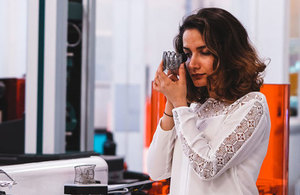Photocentric: company wins Queen’s Award for International Trade
Peterborough-based 3D printer and resin manufacturer recognised for outstanding 3-year growth in overseas sales.

Hanifeh Zarezadeh, 3D Development Engineer at Photocentric, examines the quality of jewellery 3D prints.
Award-winning innovation
The Queen’s Awards for Enterprise recognise the contributions and outstanding achievement of UK businesses in innovation, international trade, sustainable development and promoting opportunity through social mobility.
The founder of Photocentric, Paul Holt, said:
This is wonderful news for our business and we are very proud to be a winner of this prestigious award. We have always tried to innovate with new product ideas and being in a niche sector has meant that we have had to export to gain sales growth.
This year we expect to sell over £2.3 million of 3D printers and photopolymers, rising to over £8 million by 2020 – all from an invention in 2014 which was a consequence of an Innovate UK grant. More than 74% of our sales are to overseas markets.
In March this year, Photocentric also received the Manufacturing Innovation Award at the Made in Central and East England Awards. Earlier, in February, the company was selected as a CommonwealthFirst Export Champion by the Commonwealth Enterprise and Investment Council.
This isn’t the first time the company has won a Queen’s Award. In 2016 Photocentric received the award for Enterprise: Innovation.
Photocentric leads development in 3D printing
Photocentric began in 2002 with the aim of making the creation of business stamps simpler and cheaper. Since then, the company has evolved into manufacturing 3D printers and patented photopolymer packs for making stamps. It is now the largest clear stamp manufacturer outside China.
The 3D printers developed by Photocentric operate using patented technology to create a 3D object from a 2D image on a screen. They use the light emitted from an LCD screen that was originally intended for use in a mobile, tablet or TV to harden a special polymer made to react in daylight. The printers make both extremely high-resolution objects and very large format ones.
Photocentric has been able to produce the printers at lower costs than alternative methods because the screens are made for mass-market applications. This has widened the scope of possible applications, including prototype building and small-scale manufacturing.
Manufacturing and materials of the future is a core area in the government’s Industrial Strategy. Through the Industrial Strategy Challenge Fund it is seeking new, affordable, light-weight composite materials.
Find out more about the manufacturing and materials challenge.

Kalvis Gredzens and Richard Wenborn, 3D Development Engineers at Photocentric, developing the next generation of Liquid Crystal 3D Printers.
A growth in sales and scientific staff
Holt said:
A grant from Innovate UK in 2014 helped us to develop a prototype and employ a new chemist. A few months later - and much to my amazement - the chemist created a 3D printed rook. It was a very bad one, but it was the most significant object we will ever print.
The impact on our business has been completely transformative. This year, we will invest over £1 million in R&D and we are working with some of the best universities and biggest companies in the world.
The company’s strategy is based on product development and innovation, together with competitive pricing and excellent customer service.
Over the last 5 years, sales have grown from £2.5 million to £5.7 million, with exports rising from £1.7 million to over £4 million. Their US subsidiary has further sales of over $3 million.
Photocentric has also created 35 new jobs – almost doubling its workforce to 80. The company has a distribution network covering more than 50 countries worldwide.